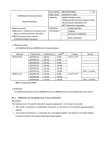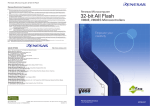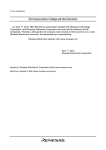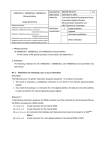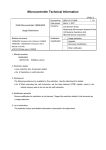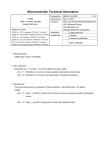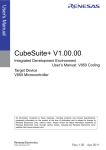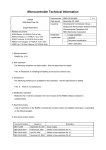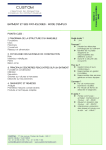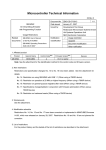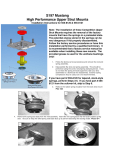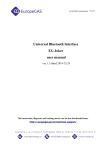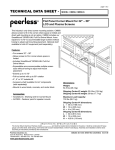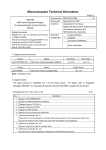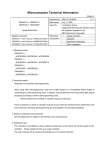Download V850ES/Jx3 Microcontrollers Usage Restrictions
Transcript
V850ES/Jx3 Microcontrollers
Document No.
ZBG-CC-09-0047
Date issued
November 9, 2009
Issued by
Product Solution Group
Multipurpose Microcomputer Systems Division
Microcomputer Operations Unit
NEC Electronics Corporation
Usage Restrictions
Related documents:
V850ES/JG3 Hardware User’s Manual:
Notification
classification
U18708EJ2V0UD00 (2nd edition)
√
1/4
Usage restriction
Upgrade
Document modification
V850ES/JJ3 Hardware User’s Manual:
U18376EJ3V0UD00 (3rd edition)
V850ES Architecture User’s Manual:
Other notification
U15943EJ3V0UM00 (3rd edition)
1. Affected products
All V850ES/Jx3 microcontrollers
V850ES/JG3: μPD70F3739, μPD70F3740, μPD70F3741, μPD70F3742
V850ES/JJ3: μPD70F3743, μPD70F3744, μPD70F3745, μPD70F3746
2. Notification
The following restriction for the V850ES/Jx3 microcontrollers has been found.
No. 1
Restriction on executing a mul or mulu instruction
Description:
The following occur if a specific instruction sequence (sequence 1 or 2 below) is executed.
• The result of executing a multiplication instruction is not stored in the relevant general-purpose
register.
• As a result of executing an ld instruction for a mis-aligned address, the data at an incorrect address
is read and stored in the relevant general-purpose register.
Sequence 1:
In the following instruction sequence, the RAM is read by one of the instructions in (2) at the same time as
the RAM is accessed by a DMA transfer:
(1) ld or sld:
A load instruction for the internal ROM
(2) ld or sld:
A load instruction for the internal RAM
(3) mul or mulu: An instruction that multiplies word data and whose result is truncated to 32 bits
...
(4) ld or sld:
Note 2
A load instruction for a mis-aligned address in the internal ROM or RAM
Note 1
ZBG-CC-09-0047
2/4
Notes 1. For a mul or mulu instruction, the operation described in this restriction occurs if r0 is
specified for the third operand (reg3), or the same register is specified for the second
operand (reg2) and third operand (reg3), as shown below:
mul reg1, reg2, reg3 (reg3 = r0 or reg2 = reg3)
mul imm9, reg2, reg3 (reg3 = r0 or reg2 = reg3)
mulu reg1, reg2, reg3 (reg3 = r0 or reg2 = reg3)
mulu imm9, reg2, reg3 (reg3 = r0 or reg2 = reg3)
For a program written in C, the CA850 does not generate the mul and mulu instructions if the
same register is specified for the reg2 and reg3 operands.
2. This restriction applies if it takes 2 clock cycles or less between the instructions in (3) and (4).
This restriction does not apply in any of the following cases:
• DMA is not used to transfer data to or from the internal RAM.
• The data read by the load instruction in (1) is used to specify the target address of the load instruction
in (2).
• The data read by the load instruction in (2) is referenced by the multiplication instruction in (3).
• The data obtained by the multiplication instruction in (3) is used to specify the target address of the
load instruction in (4).
• The data obtained by the multiplication instruction in (3) is referenced by an instruction executed
between the instructions in (3) and (4).
• At least one of the following instructions is executed between the instructions in (3) and (4):
¾
A multiplication instruction (mul, mulh, mulhi, mulu)
¾
A bit manipulation instruction (clr1, not1, set1, tst1)
¾
A special instruction (callt, dispose, switch)
• The instruction in (4) is a load instruction that accesses the memory in bytes (ld.b, ld.bu, sld.b,
or sld.bu).
• The instructions in (1) to (4) are located in an external memory or the internal RAM.
Sequence 2:
In the following instruction sequence, access by the instruction in (1) ends at the same time as the
instruction in (2) accesses the internal RAM:
(1) ld or sld:
...
(2) ld or sld:
A load instruction for an external memory
Note 1
A load instruction for the internal RAM
(3) mul or mulu: An instruction that multiplies word data and whose result is truncated to 32 bits
...
(4) ld or sld:
Note 3
A load instruction for a mis-aligned address in the internal ROM or RAM
Note 2
ZBG-CC-09-0047
3/4
Notes 1. This restriction applies if a different instruction is executed between the load instructions in (1)
and (2), and the access by the instruction in (1) ends at the same time as the instruction in (2)
accesses the internal RAM.
2. For a mul or mulu instruction, the operation described in this restriction occurs if r0 is
specified for the third operand (reg3), or the same register is specified for the second
operand (reg2) and third operand (reg3), as shown below:
mul reg1, reg2, reg3 (reg3 = r0 or reg2 = reg3)
mul imm9, reg2, reg3 (reg3 = r0 or reg2 = reg3)
mulu reg1, reg2, reg3 (reg3 = r0 or reg2 = reg3)
mulu imm9, reg2, reg3 (reg3 = r0 or reg2 = reg3)
For a program written in C, the CA850 does not generate the mul and mulu instructions if the
same register is specified for the reg2 and reg3 operands.
3. This restriction applies if it takes 2 clock cycles or less between the instructions in (3) and (4).
This restriction does not apply in any of the following cases:
• An external bus is not used.
• The data read by the load instruction in (1) is used to specify the target address of the load instruction
in (2).
• The data read by the load instruction in (1) is referenced by an instruction executed between the
instructions in (1) and (2).
• The data read by the load instruction in (2) is referenced by the multiplication instruction in (3).
• The data obtained by the multiplication instruction in (3) is used to specify the target address of the
load instruction in (4).
• The data obtained by the multiplication instruction in (3) is referenced by an instruction executed
between the instructions in (3) and (4).
• At least one of the following instructions is executed between the instructions in (3) and (4):
¾
A multiplication instruction (mul, mulh, mulhi, mulu)
¾
A bit manipulation instruction (clr1, not1, set1, tst1)
¾
A special instruction (callt, dispose, switch)
• The instruction in (4) is a load instruction that accesses the memory in bytes (ld.b, ld.bu, sld.b,
or sld.bu).
• The instructions in (1) to (4) are located in an external memory or the internal RAM.
Workaround:
Action for systems being developed and to be developed in future:
We regard this as a restriction related to the CPU’s features and do not intend to correct the
microcontroller. Instead, the CA850 compiler will be modified to automatically prevent instructions to
which this restriction applies from being generated. This workaround does not work for instructions in
assembly code, so the CA850 outputs a message for such instructions. How NEC Electronics will
provide the update for the compiler is shown below.
If you are using another compiler, contact an NEC Electronics sales representative.
ZBG-CC-09-0047
4/4
• If your compiler is the NEC Electronics compiler CA850:
The CA850 will be upgraded to add the above workaround.
The following table shows the version and release schedule for the C compiler package CA850, and
the software package SP850 that includes the CA850.
Product Name
SP850,
Current CA850
Version of CA850
Version
After Upgrade
V3.40
V3.42
CA850
Language
Release Schedule
Japanese
November 9, 2009
English
November 9, 2009
Action for already-developed systems:
Use the interview sheet in attachment 2 to check whether the restriction applies.
Application of this restriction to embedded software products:
This restriction applies to NEC Electronics real-time OSs and middleware as follows:
• Real-time OSs:
RX850:
The restriction does not apply.
RX850 Pro: The restriction does not apply.
RX850V4:
The restriction does not apply.
• Middleware:
GOFAST:
The restriction does not apply.
JPEG:
The restriction does not apply.
For products other than the above, contact an NEC Electronics sales representative. For third-party
products, contact the vendor of the product.
Modification:
The device will not be corrected, so regard this restriction as a specification.
Use the latest compiler to avoid this restriction.
3. Development environment required to work around this restriction
Use NEC Electronics compiler CA850 V3.42 or later.
Note that the outputs from the above version might differ from the outputs from the older versions.
If you are using another compiler, contact an NEC Electronics sales representative.
4. Document revision history
Document Number
ZBG-CC-09-0047
Issued on
November 9, 2009
Description
1st edition. Restriction no. 1
ZBG-CC-09-0047
Attachment 1 - 1/1
V850ES/Jx3 Microcontroller Usage Restrictions
Restriction
No.
Nickname
Product
Note
Development Environment
in Which the Restriction
Can Be Worked Around
1
Restriction on executing a mul or
V850ES/
μPD70F3739
U
Category: Compiler
mulu instruction
JG3
μPD70F3740
U
Product name: CA850
μPD70F3741
U
Version: V3.42 or later
μPD70F3742
U
V850ES/
μPD70F3743
U
JJ3
μPD70F3744
U
μPD70F3745
U
μPD70F3746
U
Note
Whether or not the restriction applies
Remark
The meaning of each symbol for Note is as follows:
−: Restriction does not apply
{: Restriction is already corrected
×: Restriction applies (correction is planned)
U: Restriction applies (correction is not planned)
ZBG-CC-09-0047
Attachment 2 - 1/2
• First judgment: Judgment based on product usage conditions
Check the conditions under which you are using the product to see whether the restriction applies to
the product. If the restriction might apply, perform a second judgment. If the restriction is judged to be
not applicable, subsequent checking is not necessary.
Checking the usage conditions
Select Yes or No for whether the features in (1) and (2) below are used. If there is no item for
which Yes is selected, the restriction does not apply.
(1) Data is not transferred to or from the internal RAM using DMA.
Yes
No
(2) An external bus interface is used.
Yes
No
ZBG-CC-09-0047
Attachment 2 - 2/2
• Second judgment: Judgment based on compiling conditions
Interview Sheet (for second judgment)
Use the following flowchart to judge whether the restriction applies. If the restriction might apply, a third
judgment using check tools is required.
Start
Is the source code
available and is the
CA850 or a GHS
compiler used?
Go to third judgment
using check tools
No
Use the check tool for
hex objects.
When executing the
check tool, specify
the -Missalign=Y
option.
Yes
Yes
Is there assembly
code?
Check both the
assembly source
and C source.
Ì Checking the
C source
Checking the
assembly source
Yes
Go to third
judgment using
check tools
Use the check tool for
hex objects.
When executing the
check tool, specify the
-Missalign=Y option.
Be sure to also check
the C source according
to the procedure
following Ì in this
flowchart.
No
Is accessing a misaligned address specified
intentionally in the C
source? (Note 3)
Is a mul or mulu
instruction used in the
source code?
No
Use the check tool for
the assembly list.
When executing the
check tool, specify
the -Missalign=Y
option.
No
Restriction
does not apply
Be sure to also check the
C source according to the
procedure following Ì in
this flowchart.
If the restriction is not
judged to apply to either
assembly or C, the
restriction does not apply
to your code.
Go to third
judgment using
check tools
Yes
Is the compiler
CA850 made by
NECEL used?
Yes
(CA850)
No
(GHS compiler)
Is structure packing
at compile time
specified (Note 2)?
Note 1: When using the CA850
The restriction might apply if either the
following conditions is satisfied:
Is structure packing
at compile time
specified (Note 1)?
No
No
1. #pragma pack(1) or #pragma
pack(2) is specified in the source code.
Restriction
does not apply
Yes
Yes
Restriction
does not apply
2. -Xpack=1 or -Xpack=2 is specified as a
compiler option.
Note 2: When using a GHS compiler
The restriction might apply if either the
following conditions is satisfied:
1. #pragma pack(1) or #pragma
pack(2) is specified in the source code
and -misalign_pack is specified as a
compiler option.
2. -pack=1 or -pack=2 and
-misalign_pack are specified as
compiler options.
Go to third
judgment using
check tools
Use the check tool for
the assembly list.
When executing the
check tool, specify
the -Missalign=Y
option.
Note 3: A mis-aligned address might
be accessed if a pointer to a char is
cast to a pointer to an int to
reference the int, as shown below.
func()
{
char
int
*ptr_char=“abcdef” ;
data, *ptr_int ;
ptr_int= (int *)
(ptr_char+2);
data = *ptr_int;
}








